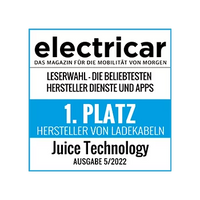Best of Hotline

We have been operating our free hotline since spring 2014. We love this job because nowhere else are we more in tune with people's needs. This means we can provide e-drivers with more and more relevant expertise and innovative products.
Here you will find a selection of the most exciting and frequently asked questions and answers.
1. Where can I charge when I'm on the go?
Anywhere there is a power socket. Be it at public charging stations or at the restaurant where you are eating lunch, in your holiday home, etc. These are just a few options for how you can recharge your electric gem. The statement that there are not enough public charging stations for electric cars to be able to drive across Europe without worry is probably justified. But what most people don't know is that you can always have your own charging station with you.
Various manufacturers offer mobile chargers that are much more powerful than those supplied by the car manufacturer. The mobile chargers can be plugged into practically any socket using adapters and, depending on the current strength, the car can be fully charged within a few hours. So if you were to mark every socket in the world as a potential charging station on a map in red, the map would probably be nothing but red.
2. How long does it take for my car to be "full of fuel"?
If you charge your car using a standard household socket, it will take 8-12 hours - depending on the vehicle, of course. But even that can be put to good use if you are staying in a hotel or holiday home anyway.
You can calculate the charging speed, which depends on the charging capacity of the battery, using the following formula:
Ampere * number of phases = km per hour.
"But the electricity also has to come from somewhere."
"These cars are just as energy-intensive to manufacture."
"These batteries have to be disposed of somehow."
3. How environmentally friendly are electric cars really?
Let's be honest: finding a way to move around in everyday life in a completely energy-neutral way at the speeds required today is and will probably remain wishful thinking. And if there were such a perfect solution, we probably wouldn't be thinking about e-mobility right now. Today, we have such high demands on mobility that it is unavoidable to make certain compromises. It goes without saying that an electric car has to be manufactured in exactly the same way as a petrol car. (Although this is not entirely true of the BMW i3. It is made exclusively from recycled materials.) The electricity that is required can be produced very environmentally friendly using wind or water energy and does not necessarily require the production of solar panels (which again emits CO2). Although this would probably be more environmentally friendly than using petroleum, especially when you think of all the collateral damage that occurs when oil is extracted. Not to mention the transport of the oil and gas and the infrastructure required for this. As far as the batteries are concerned, the statement can actually be deleted. They are not simply disposed of, but the components are recycled. Yes, an electric car also has to be produced before you can drive it, and this is usually not emission-free. Everyone seems to agree on that. What often causes debate is the question of the extent to which the electric car makes up for the production emissions by saving fuel. Studies show that, depending on the car, fuel savings can bring the production emissions back to zero after 27,000 km. And don't forget: a petrol car also has to be produced.
4. Where can I go abroad if I am travelling with (my) electric vehicle?
If I have a problem with a petrol car, I drive to the nearest garage, no matter what country I'm in. Someone will be able to fix it, these combustion engines are the same everywhere. Not so with electric motors. The fear of being left alone with a defective electric car somewhere in unfamiliar territory is apparently pretty great.
However, if you do have a problem with your electric car, you can usually go to any workshop. Everything that doesn't have to do with the underlying electronics (battery management, etc.) is no different from that of a petrol car. As far as the electrics are concerned, most breakdown services in neighboring countries now have trained emergency personnel for problems of this kind.
5. How does an electric car react to temperature differences?
Exactly. At 20°C the charge status is 100%. At 15°C it is 50% and at 0°C the battery discharges itself. Nonsense. Of course the temperature affects the electrical energy, but not so much that you have to worry about it. Temperatures below 5°C can cause up to 25% loss of range. You can find more information about external influences on the range here.
6. Don't I need to have an electrician's qualification to be able to handle an electric vehicle properly?
Counter question: Do you have to be a trained car mechanic to drive a car with a combustion engine? The technology is new, but not nearly as scary as many people seem to think. Thanks to today's use of cell phones, laptops, etc., we've already got the hang of connecting an electrical device. And charging a car is actually no different. Plug in, connect, charge. And when it comes to installing a permanent charging station in your own garage - well, that's what technicians are for.
7. How long does it take to pay for the purchase of an electric car?
On average, the slightly higher price of an electric car pays for itself after around 160,000 km. With an expected lifespan of easily 500,000 km or more (because it simply has no parts that can break), you will save a lot of money with e-driving even if you buy one today.
8. Why do I need a so-called charging box? Isn't a normal power socket enough?
Since March 2013, the Type 2 plug has been the defined standard in Europe for charging electric vehicles. This plug is also found on the Model S. It consists of the 5 poles that can also be found on the three-phase sockets (CEE16 red and CEE32 red) and - very important - 2 additional communication poles. These "talk" to the vehicle to increase safety when dealing with high voltage. For example, the current is only fed to the Type 2 connector when a vehicle is connected and has confirmed that it is locking the Type 2 connector. Therefore, communication logic and a "switching point" (charging contactor) are ALWAYS required between the power supply and the vehicle. In the Tesla charger (called UMC - Universal Mobile Connector), this logic is located in the small box in the middle of the cable, but it can also be housed in a wall box or in a mobile box. In public charging stations, the logic is located in the charging station itself or in the wall behind it.
9. Why do normal (commercially available) country adapters cause problems?
Most adapters have a fuse built in (fixed or, in the best case, replaceable) that trips at 10A. Most adapter plugs or travel adapters, even expensive branded products, can therefore only be loaded up to 10A, and in continuous operation often only 8A. This means you can charge about 6 - 8 km per hour - pointless.
10. Do I need surge protection?
No. The UMC (Tesla Universal Mobile Connector, which is supplied with the vehicle) checks the voltage before charging begins and only allows the correct voltage into the car. If you charge using a charging box, this performs the same task.
11. Do I need a lightning protection adapter?
Until now, no one has really been able to say how the UMC (Tesla's Universal Mobile Connector, which is delivered with the vehicle) filters out short, high surges and how charging boxes react to them.
12. Do I need residual current device protection?
Responsible charging box providers generally point out that residual current protection must be installed on site (i.e. in the home's electrical installation). For high voltage current (three-phase), it must be a type B residual current device, unless DC fault currents cannot be ruled out. This is the case if the battery in the car is not galvanically isolated (currently the case with the Renault Zoe). However, this is quite expensive and costs between around EUR 400 and 800 on the market. This means that additional residual current protection in a home or mobile charging box is not necessary. On closer inspection, it also seems logically much more sensible to protect the entire supply line if possible (i.e. from the house distributor) and not just the last few meters between the charging box and the car, especially since the splash-proof type 2 plug only carries power when it is plugged in correctly and cleanly.
13. Why do you also supply Schuko extension cables in Switzerland?
The Schuko plug itself and the cross-section of our cable are designed for 16A. This means you can safely draw 16A if the house installation allows it. With the Swiss (and other) adapters included in the set, you can still get into any socket and are then on the safe side in terms of transmission. In addition, you can probably wait a little longer for the Swiss attachment for the UMC, so our extension cable goes directly to the UMC plug from Tesla.
14. Why can I only charge 13A on a Schuko socket when Schuko is approved up to 16A?
The plug-in adapters on the UMC have a built-in resistor. This limits the Schuko adapter to 13A and the CEE16 adapter to 16A. Correct Schuko sockets can, however, offer 16A, which is why we have an adapter in the set that connects the Schuko socket to the UMC via a CEE16 plug. Problem solved.
15. Why does the UMC sometimes light up red when I plug it into a Schuko socket?
The voltage-testing resistor (see previous question) is between the neutral conductor and earth. This means that the Schuko plug is now suddenly direction-dependent. Tesla had a 50% chance of assembling it according to the applicable installation practice - and lost. This is why you have to plug the UMC into most sockets with the Schuko adapter facing upwards. It gets really bad in France with the protruding earthing pin. You absolutely need a country adapter plugged in between (of course included in the CONNECT EVERYWHERE set) to get the earthing hole on the other side. This is why you have to plug the UMC into most sockets with the Schuko adapter facing upwards.
16. How do I correctly bill for electricity consumption in private homes or restaurants?
Exactly: If you charge in single phase (i.e. with 230V), V x A = W. If you charge in three phase (i.e. with 400V), then (V x A) x root 3 = W. Then multiply the result by the local kilowatt electricity price (you can google this in your car) and the charging time in hours. In Switzerland, a kW/h at the high tariff costs around CHF 0.25 to 0.35, depending on the region. In Germany, it is probably less. Example: Charging for 2 hours during lunch at a red CEE16 socket: 16A x 230V x 3 phases x 2 hours = 22 kW/h x CHF 0.25 at the high tariff = CHF 5.50 total electricity costs.
17. Why can I set the desired amperage in the car?
Charging means drawing a large amount of electricity over the cable in continuous operation. It is important to know that many installations are not designed to deliver the maximum possible power over several hours. Depending on the plug configuration or when charging via a charging box, every driver must always be aware that the sole responsibility for the charge (and possible overheating with the consequences of a fire) lies with him. Therefore, always check again how much the car will draw now.
18. So do I always have to check the amperage at home too?
No, where the Model S has already charged, it remembers the settings (based on the GPS data). So if you always use 16A at home from 10 p.m. (night power), then you can just plug it in without checking, which means you can get to the living room with your whiskey 10 seconds faster.
19. What types of snow chains are there and are they even necessary?
Full-fledged snow chains and drive chains.
- Full-fledged snow chains form a net that is pulled over the tread of the tires. Depending on the arrangement of the chains, a further distinction is made between drive chains and track chains.
- Drive chains prevent the wheels from spinning. They are mounted on the wheels of the drive axle(s). The chain sections that are intended to prevent the wheels from slipping run across the running surface. The track chains are mounted on the wheels of the steering axle(s) and provide the wheels with longitudinal guidance to prevent them from slipping sideways. Here the main chain sections run in the direction of travel.
Today, most chains used on cars or trucks are a combination of drive and track chains. The chain sections run criss-cross across the tread and are repeatedly connected to longitudinal sections. Pure drive chains are mainly used on construction machines or tractors in forestry operations for hauling timber.
materials
- The chain links are made of hardened steel, plastic, textiles or other materials. They are usually angular to provide better friction resistance. There are often loose round chain links that are intended to continuously free the rolling chain of adhering snow.
need
But experience is the best way to show how necessary the chains really are. We followed the recommendation of a man from Engadine, the manager of a transport company, who drives over the Julier Pass at least three times a week in winter, whatever the weather. He says:
- "You hardly ever need chains.
- But if you want to buy, go for ones that are easy to assemble (and disassemble!).
- The simpler the construction, the more functional. I always buy the cheapest ones and they work great. They are consumables.
- Never drive faster than 40 km/h with chains. Put them on before you get stuck, but take them off before the road clears of snow.
- Chains always belong on the drive axle and only there. (Old Engadine wisdom: rear-wheel drive with chains at the front = Dutch.)
- Forget all the talk about chain link thicknesses etc. Whatever fits your bike will do the job perfectly."
Questions about the Tesla Model S
1. Why can I no longer charge at individual sockets since the January 2014 update?
With the last update, Tesla secretly installed software that monitors the drop in voltage when charging begins. The idea behind this is that "bad" cables create more resistance and thus the voltage drops when power is drawn. As a result, the Model S refuses to charge at all. However, since the voltage can fluctuate depending on the region or installation, even with completely correct and cleanly installed cables, this test routine is pretty pointless. A car that you don't know whether you can charge in the hotel of your next business meeting, for example, is useless.
2. Why does my Model S only show 230V charging current even when using a 400V socket?
Because there is 230V between each of the three phases and the neutral conductor. So the car is measuring correctly and the small 3 in the circle shows that it is charging in three phases. Incidentally, there is only 400V between the individual phases themselves, which is where the name comes from.
Questions about our shop
1. Wouldn't it be cheaper if I bought the parts individually?
There is nothing in the world that someone cannot make a little worse and therefore offer a little cheaper. We have now invested hundreds of hours to find as much quality as necessary (but no more) at the cheapest price possible (but no less). We have negotiated well and by purchasing in bulk we are sure that our prices can stand up to any comparison for the same quality. Previous customers confirm our assessment that buying in-house is between 30 and 50% more expensive.
2. Where are these quality limits?
There are countless details to pay attention to and we have discovered them through a lot of hard work and testing. The most relevant are the following:
- The world adapter set must be suitable for 16A. Most commercially available sets have their own fuses in individual adapters, usually limited to 10A. To make matters worse, these will blow even at 10A continuous consumption, which means the adapters are only suitable for 8A continuous consumption. Unusable for charging purposes.
- The CEE32 to CEE16 adapter must be suitable for 11kW. Most commercially available adapters are only protected with 7kW, which is usually not even indicated. The reason is the much cheaper built-in fuse - but unfortunately this doesn't make sense for charging purposes.
- Many extension cables have wire cross-sections that are too small (see cable diameter) or the plugs are cheaply and poorly assembled. This lowers the price but unfortunately also the usefulness. In any case, it is useless and dangerous for charging purposes.
- All of our adapters are custom-made, optimized in terms of length and weight. We use particularly short and handy plugs made of plastic that slides easily. The difference with a CEE16 plug, for example, is considerable. Plugging and unplugging requires less effort, there is no jamming, and the plug takes up less space when stored. The cable sections between the adapters are around 30cm long, just enough to make comfortable connections and not exert pressure on wall sockets. And just enough to avoid unnecessary copper lugging around and taking up storage space.
- Our extension cables use the same high-quality plugs. All are splash-proof and particularly robust. The cables themselves are particularly flexible and therefore easy to lay out and put back together. This makes a huge difference, especially when the cables are wet or cold.
- Our set contains adapters that are not available off the shelf anyway and that we have specially manufactured. For example, the adapter T15 (16A 3-phase Switzerland) to CEE 16 or adapters from Schuko or CEE32A blue to CEE red. You will rarely need some adapters, but the maxim of our set is: Wherever you go in Europe, as soon as you find electricity, you can charge. Always.
- The Type 2 cable is available in numerous versions on the market. Many of them are designed for low charging power, often limited to 20A, for example. Our cables are of course 32A compatible and also TÜV-tested. If you have a double charger, 32a is a must anyway. Since Type 2 is the defined standard in Europe, it also makes sense for single charger owners to buy a cable that is future-proof thanks to its high performance. The additional costs (which are low in our case) are definitely worth it - whether you might have a double charger installed later, whether you can still use the cable in your next car, or just for the resale value.
Another side note: If you buy too cheaply, you usually buy twice.
3. Why are the Type 2 cables at e-driver.net so cheap?
Because we buy in large quantities and negotiate hard. It is first-class quality, TÜV-tested and, as mentioned, 32A Mode3-capable. We tested 14 cables available on the market and selected the best by far. Our cable is characterized by the highest level of flexibility, which makes it very pleasant to handle and put together. The plugs are handy and easy to grip, with rubber inserts on the sides that make them easy to grip at any temperature and fit in both large and small hands. Thanks to their small design, they take up little space when stored (that really makes a difference!) and they fit in all charging stations (some competitors have plug shapes that are so awkward that you can't plug them into recessed sockets). They even have protective caps and a professional Velcro strap, something other manufacturers can only dream of.
4. Can I purchase the bag separately?
Yes, in order to make use of the frunk niche, we also sell the bag empty. Because it fits perfectly into the frunk niche and stays there even when not attached, even when braking hard, it is the perfect solution for using this storage space. The bag also fits perfectly in the trunk. So you have the choice. Some customers use the trunk basement for all of their charging accessories, where they put additional cables and a mobile charger in addition to the bag with the adapter.













